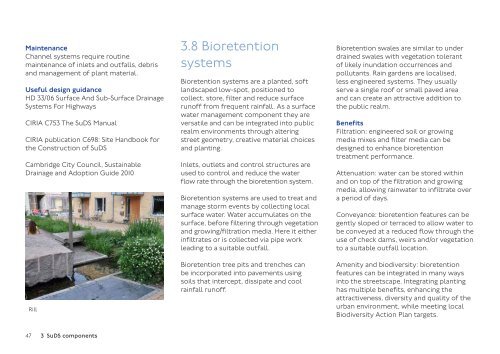SuDS in London - a guide
sustainable-urban-drainage-november-2016
sustainable-urban-drainage-november-2016
You also want an ePaper? Increase the reach of your titles
YUMPU automatically turns print PDFs into web optimized ePapers that Google loves.
Ma<strong>in</strong>tenance<br />
Channel systems require rout<strong>in</strong>e<br />
ma<strong>in</strong>tenance of <strong>in</strong>lets and outfalls, debris<br />
and management of plant material.<br />
Useful design guidance<br />
HD 33/06 Surface And Sub-Surface Dra<strong>in</strong>age<br />
Systems For Highways<br />
CIRIA C753 The <strong>SuDS</strong> Manual<br />
CIRIA publication C698: Site Handbook for<br />
the Construction of <strong>SuDS</strong><br />
Cambridge City Council, Susta<strong>in</strong>able<br />
Dra<strong>in</strong>age and Adoption Guide 2010<br />
Rill<br />
3.8 Bioretention<br />
systems<br />
Bioretention systems are a planted, soft<br />
landscaped low-spot, positioned to<br />
collect, store, filter and reduce surface<br />
runoff from frequent ra<strong>in</strong>fall. As a surface<br />
water management component they are<br />
versatile and can be <strong>in</strong>tegrated <strong>in</strong>to public<br />
realm environments through alter<strong>in</strong>g<br />
street geometry, creative material choices<br />
and plant<strong>in</strong>g.<br />
Inlets, outlets and control structures are<br />
used to control and reduce the water<br />
flow rate through the bioretention system.<br />
Bioretention systems are used to treat and<br />
manage storm events by collect<strong>in</strong>g local<br />
surface water. Water accumulates on the<br />
surface, before filter<strong>in</strong>g through vegetation<br />
and grow<strong>in</strong>g/filtration media. Here it either<br />
<strong>in</strong>filtrates or is collected via pipe work<br />
lead<strong>in</strong>g to a suitable outfall.<br />
Bioretention tree pits and trenches can<br />
be <strong>in</strong>corporated <strong>in</strong>to pavements us<strong>in</strong>g<br />
soils that <strong>in</strong>tercept, dissipate and cool<br />
ra<strong>in</strong>fall runoff.<br />
Bioretention swales are similar to under<br />
dra<strong>in</strong>ed swales with vegetation tolerant<br />
of likely <strong>in</strong>undation occurrences and<br />
pollutants. Ra<strong>in</strong> gardens are localised,<br />
less eng<strong>in</strong>eered systems. They usually<br />
serve a s<strong>in</strong>gle roof or small paved area<br />
and can create an attractive addition to<br />
the public realm.<br />
Benefits<br />
Filtration: eng<strong>in</strong>eered soil or grow<strong>in</strong>g<br />
media mixes and filter media can be<br />
designed to enhance bioretention<br />
treatment performance.<br />
Attenuation: water can be stored with<strong>in</strong><br />
and on top of the filtration and grow<strong>in</strong>g<br />
media, allow<strong>in</strong>g ra<strong>in</strong>water to <strong>in</strong>filtrate over<br />
a period of days.<br />
Conveyance: bioretention features can be<br />
gently sloped or terraced to allow water to<br />
be conveyed at a reduced flow through the<br />
use of check dams, weirs and/or vegetation<br />
to a suitable outfall location.<br />
Amenity and biodiversity: bioretention<br />
features can be <strong>in</strong>tegrated <strong>in</strong> many ways<br />
<strong>in</strong>to the streetscape. Integrat<strong>in</strong>g plant<strong>in</strong>g<br />
has multiple benefits, enhanc<strong>in</strong>g the<br />
attractiveness, diversity and quality of the<br />
urban environment, while meet<strong>in</strong>g local<br />
Biodiversity Action Plan targets.<br />
47 3 <strong>SuDS</strong> components


